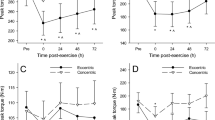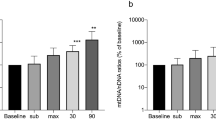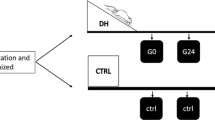Abstract
The aim of the present study was to investigate leucocyte markers, CD11b, CD16, CD66b, CD68, myeloperoxidase and neutrophil elastase on skeletal muscle biopsies from biceps brachii after unaccustomed eccentric exercise followed by the second bout of exercise 3 weeks later. The subjects (10 subjects received COX-2 inhibitor (Celecoxib) and 13 subjects received placebo) were divided into three categories: mild, moderate and severe effect of eccentric exercise, according to the reduction and recovery of muscle force-generating capacity after performing 70 maximal eccentric actions with elbow flexors on an isokinetic dynamometer. The results showed that the CD66b antibody was applicable for localization of neutrophils in human skeletal muscle, whereas the other studied neutrophil markers recognized also other leucocytes than neutrophils. The number of CD66b positive cells in skeletal muscle was very low and was not affected by the exercise. The macrophage marker CD68 showed reactivity also against satellite cells and fibroblast-like cells in skeletal muscle and therefore cannot be applied as a quantitative value for inflammatory cells. Skeletal muscle fibre injury, shown as dystrophin negative fibres, was observed approximately in half of the biopsies at 4 and 7 days after the first exercise bout in the categories moderate and severe effect of eccentric exercise. These subjects represent the most prominent loss in muscle force-generating capacity both at the category and the individual levels. Furthermore, deformed skeletal muscle fibres were observed in five subjects in these categories after the second bout of exercise. The present results suggest that neutrophils are not involved in skeletal muscle fibre injury and the reduction in muscle force-generating capacity after a single bout of eccentric exercise is a good indirect indicator of muscle damage in humans. Furthermore, prolonged regeneration process could be one of the reasons for impaired peripheral muscle function after high-force eccentric exercise.












Similar content being viewed by others
Abbreviations
- BSA:
-
Bovine serum albumin
- CD68:
-
Cluster of differentiation 68
- CEL S01:
-
Celecoxib subject 01
- DAPI:
-
4′,6-Diamidino-2-phenylindole
- g :
-
Gravity
- M r :
-
Molecular weight
- O.C.T:
-
Optimal cutting temperature
- PBO S01:
-
Placebo subject 01
- ROI:
-
Region of interest
References
Beaton LJ, Tarnopolsky MA, Phillips SM (2002) Contraction-induced muscle damage in humans following calcium channel blocker administration. J Physiol 544:849–859
Bröker BM, Edwards JC, Fanger MW, Lydyard PM (1990) The prevalence and distribution of macrophages bearing Fc gamma R I, Fc gamma R II, and Fc gamma R III in synovium. Scand J Rheumatol 19:123–135
Chen TC, Lin KY, Chen HL, Lin MJ, Nosaka K (2011) Comparison in eccentric exercise-induced muscle damage among four limb muscles. Eur J Appl Physiol 111:211–223
Clarkson PM, Hubal MJ (2002) Exercise-induced muscle damage in humans. Am J Phys Med Rehabil 81:S52–S69
Clarkson PM, Byrnes WC, Gillisson E, Harper E (1987) Adaptation to exercise-induced muscle damage. Clin Sci (Lond) 73:383–386
Crameri RM, Langberg H, Teisner B, Magnusson P, Schrøder HD, Olesen JL, Jensen CH, Koskinen S, Suetta C, Kjaer M (2004) Enhanced procollagen processing in skeletal muscle after a single bout of eccentric loading in humans. Matrix Biol 23:259–264
Crameri RM, Aagaard P, Qvortrup K, Langberg H, Olesen J, Kjaer M (2007) Myofibre damage in human skeletal muscle: effects of electrical stimulation versus voluntary contraction. J Physiol 583:365–380
Evans WJ, Cannon JG (1991) The metabolic effects of exercise-induced muscle damage. Exerc Sport Sci Rev 19:99–125
Gottfried E, Kunz-Schughart LA, Weber A, Rehli M, Peuker A, Müller A, Kastenberger M, Brockhoff G, Andreesen R, Kreutz M (2008) Expression of CD68 in non-myeloid cell types. Scand J Immunol 67:453–463
Hellsten Y, Frandsen U, Orthenblad N, Sjødin B, Richter EA (1997) Xanthine oxidase in human skeletal muscle following eccentric exercise: a role in inflammation. J Physiol 498:239–248
Hubal MJ, Rubinstein SR, Clarkson PM (2007) Mechanisms of variability in strength loss after muscle-lengthening actions. Med Sci Sports Exerc 39:461–468
Kawanaka N, Yamamura M, Aita T, Morita Y, Okamoto A, Kawashima M, Iwahashi M, Ueno A, Ohmoto Y, Makino H (2002) CD14+, CD16+ blood monocytes and joint inflammation in rheumatoid arthritis. Arthritis Rheum 46:2578–2586
Kunisch E, Fuhrmann R, Roth A, Winter R, Lungershausen W, Kinne RW (2004) Macrophage specificity of three anti-CD68 monoclonal antibodies (KP1, EBM11, and PGM1) widely used for immunohistochemistry and flow cytometry. Ann Rheum Dis 63:774–784
La Rocca G, Anzalone R, Farina F (2009) The expression of CD68 in human umbilical cord mesenchymal stem cells: new evidences of presence in non-myeloid cell types. Scand J Immunol 70:161–162
Lauritzen F, Paulsen G, Raastad T, Bergersen LH, Owe SG (2009) Gross ultrastructural changes and necrotic fiber segments in elbow flexor muscles after maximal voluntary eccentric action in humans. J Appl Physiol 107:1923–1934
MacIntyre DL, Reid WD, McKenzie DC (1995) Delayed muscle soreness. The inflammatory response to muscle injury and its clinical implications. Sports Med 20:24–40
MacNeil LG, Baker SK, Stevic I, Tarnopolsky MA (2011) 17β-estradiol attenuates exercise-induced neutrophil infiltration in men. Am J Physiol Regul Integr Comp Physiol 300:R1443–R1451
Mahoney DJ, Safdar A, Parise G, Melov S, Fu M, MacNeil L, Kaczor J, Payne ET, Tarnopolsky MA (2008) Gene expression profiling in human skeletal muscle during recovery from eccentric exercise. Am J Physiol Regul Integr Comp Physiol 294:R1901–R1910
Malm C, Nyberg P, Engstrom M, Sjodin B, Lenkei R, Ekblom B, Lundberg I (2000) Immunological changes in human skeletal muscle and blood after eccentric exercise and multiple biopsies. J Physiol 529:243–262
Malm C, Sjödin TL, Sjöberg B, Lenkei R, Renström P, Lundberg IE, Ekblom B (2004) Leukocytes, cytokines, growth factors and hormones in human skeletal muscle and blood after uphill or downhill running. J Physiol 556:983–1000
McHugh MP (2003) Recent advances in the understanding of the repeated bout effect: the protective effect against muscle damage from a single bout of eccentric exercise. Scand J Med Sci Sports 13:88–97
Middleton SJ, Li D, Wharton S, Reynolds PD, Wraight EP, Hunter JO (1995) Validation of 99Tcm-HMPAO leucocyte scintigraphy in ulcerative colitis by comparison with histology. Br J Radiol 68:1061–1066
Mikkelsen UR, Langberg H, Helmark IC, Skovgaard D, Andersen LL, Kjaer M, Mackey AL (2009) Local NSAID infusion inhibits satellite cell proliferation in human skeletal muscle after eccentric exercise. J Appl Physiol 107:1600–1611
Nosaka K, Sakamoto K (2001) Effect of elbow joint angle on the magnitude of muscle damage to the elbow flexors. Med Sci Sports Exerc 33:22–29
Paulsen G, Egner IM, Drange M, Langberg H, Benestad HB, Fjeld JG, Hallén J, Raastad T (2010a) A COX-2 inhibitor reduces muscle soreness, but does not influence recovery and adaptation after eccentric exercise. Scand J Med Sci Sports 20:e195–e207
Paulsen G, Crameri R, Benestad HB, Fjeld JG, Mørkrid L, Hallén J, Raastad T (2010b) Time course of leukocyte accumulation in human muscle after eccentric exercise. Med Sci Sports Exerc 42:75–85
Peake J, Nosaka K, Suzuki K (2005) Characterization of inflammatory responses to eccentric exercise in humans. Exerc Immunol Rev 11:64–85
Peterson JM, Trappe TA, Mylona E, White F, Lambert CP, Evans WJ, Pizza FX (2003) Ibuprofen and acetaminophen: effect on muscle inflammation after eccentric exercise. Med Sci Sports Exerc 35:892–896
Prior BM, Jayaraman RC, Reid RW, Cooper TG, Foley JM, Dudley GA, Meyer RA (2001) Biarticular and monoarticular muscle activation and injury in human quadriceps muscle. Eur J Appl Physiol 85:185–190
Przybyla B, Gurley C, Harvey JF, Bearden E, Kortebein P, Evans WJ, Sullivan DH, Peterson CA, Dennis RA (2006) Aging alters macrophage properties in human skeletal muscle both at rest and in response to acute resistance exercise. Exp Gerontol 41:320–327
Raastad T, Risoy BA, Benestad HB, Fjeld JG, Hallen J (2003) Temporal relation between leukocyte accumulation in muscles and halted recovery 10–20 h after strength exercise. J Appl Physiol 95:2503–2509
Sayers SP, Clarkson PM (2001) Force recovery after eccentric exercise in males and females. Eur J Appl Physiol 84:122–126
Scott A, Khan KM, Cook JL, Duronio V (2004) What is “inflammation”? Are we ready to move beyond Celsus? Br J Sports Med 38:248–249
Smith LL (1991) Acute inflammation: the underlying mechanism in delayed onset muscle soreness? Med Sci Sports Exerc 23:542–551
Stauber WT, Clarkson PM, Fritz VK, Evans WJ (1990) Extracellular matrix disruption and pain after eccentric muscle action. J Appl Physiol 69:868–874
Stupka N, Tarnopolsky MA, Yardley NJ, Phillips SM (2001) Cellular adaptation to repeated eccentric exercise-induced muscle damage. J Appl Physiol 91:1669–1678
Warren GL, Ingalls CP, Shah SJ, Armstrong RB (1999) Uncoupling of in vivo torque production from EMG in mouse muscles injured by eccentric contractions. J Physiol 515:609–619
Ziegler-Heitbrock L (2007) The CD14+ CD16+ blood monocytes: their role in infection and inflammation. J Leukoc Biol 81:584–592
Acknowledgments
The authors would like to thank Prof. Lars Mørkrid (Department of Medical Biochemistry, University Hospital, Oslo, Norway) for the serum creatine kinase analyses. The authors will also thank Jan Gunnar Fjeld (Department of Nuclear Medicine at Oslo University Hospital, Oslo, Norway) for the scintigraphic measurements. This study was partly financed by Pfizer Inc. (Norway). However, the authors have no economical interests in Pfizer, nor are there any contract-bond restrictions or clauses that potentially could have influenced the study. The authors at the Department of Anatomy (University of Oslo, Norway) received financial support from the Norwegian Research Council.
Author information
Authors and Affiliations
Corresponding author
Electronic supplementary material
Below is the link to the electronic supplementary material.
Rights and permissions
About this article
Cite this article
Paulsen, G., Egner, I., Raastad, T. et al. Inflammatory markers CD11b, CD16, CD66b, CD68, myeloperoxidase and neutrophil elastase in eccentric exercised human skeletal muscles. Histochem Cell Biol 139, 691–715 (2013). https://doi.org/10.1007/s00418-012-1061-x
Accepted:
Published:
Issue Date:
DOI: https://doi.org/10.1007/s00418-012-1061-x




